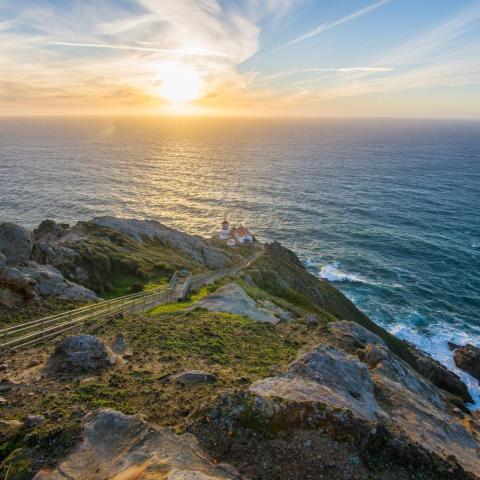
Sunset's afterglow at Ruby Beach, Olympic National Park / Rebecca Latson
Searching for a national park with a little bit of everything? Look no further than Olympic National Park in Washington State. Located on the Olympic Peninsula, you’ll find Pacific coast beaches, glaciated mountains, and lush rainforests.
Here is a place where you can explore the tidepools for colorful sea stars and giant green anemones, beachcomb for shells, sea glass and fishing floats, and stick around to watch a bright, saturated sunset. Drive from sea level to an elevation of 6,772 feet (2,064 meters) to hike the hills and mountains around Hurricane Ridge. While wandering the alpine meadows, you might spot (or hear) the endemic Olympic marmot. In between ocean and mountains are the lush, mossy green wonders of the Hoh, Quinault, Queets, and Bogachiel rainforests, where you may marvel at forest floors carpeted with lush ferns beneath towering moss-draped Sitka spruce, western hemlock, and bigleaf maple displaying every conceivable shade of green. You might even spot a banana slug minding its own business beneath the vegetation, or – if you visit during September - hear the high-pitched bugle of Roosevelt elk during mating season.
Speaking of Roosevelt elk, this large mammal as well as the old-growth forests are the main reasons for Olympic National Park’s establishment.
According to park staff:
In 1897 the area received its first national designation, as Olympic Forest Reserve, by President Grover Cleveland in response to concern about the area's disappearing forests. Eight years later, in 1909, President Teddy Roosevelt designated a part of the reserve as Mount Olympus National Monument to protect the habitat of Roosevelt Elk, whose population was in steep decline. These efforts are why the once-named Olympic Elk are now called Roosevelt Elk in this president’s honor.
In 1937 President Franklin Roosevelt visited the Olympic Peninsula and added his support to establishment of a national park. The following year he signed the act designating Olympic National Park. An additional area of Pacific coast was added in 1953.
The park’s diverse ecosystems allow for a wide variety of outdoor activities such as hiking (over 600 miles of frontcountry and backcountry trails), climbing, fishing (salmon, trout, char), tidepooling, boating/paddling, and wildlife viewing. If you enjoy snowshoeing, cross-country skiing, and sledding, then Hurricane Ridge is the ideal setting for these winter activities. In addition to snow sports during the winter, the park’s beaches offer fantastic venues for watching dramatic storms roll landward.
To avoid the park’s storied precipitation (144 inches/366 centimeters per year on average in the Hoh Rain Forest, alone), most visit during the summer, making it the busiest (and most crowded) season of the year. While summer is indeed drier and sunniner, there’s a moody character to be appreciated by traveling during the other three seasons. Just make sure you pack your raincoat and other weatherproof gear.
At almost 1 million acres, Olympic National Park truly requires more than one day for exploration. Sure, you can spend a full day driving from beaches to rainforests to mountains, but you’ll miss so much in between and won’t get the full flavor of each environment, not to mention how tired you will be after all that driving. Better to stay in one of five lodges (four in-park and one just outside the southwest boundary) or pitch a tent beneath the starry sky at one or more of the park’s 14 campgrounds (including campgrounds within Olympic National Forest).
When planning a visit, don’t forget to pack your camera. With so much to see and photograph there, you might want to check out this series of Traveler articles (Parts 1, 2, and 3) for capturing great shots at Olympic National Park.
Traveler’s Choice For: Backpacking, beachcombing, photography, hiking, families, tidepooling, beach sunsets, rainforest exploration




 Support Essential Coverage of Essential Places
Support Essential Coverage of Essential Places






